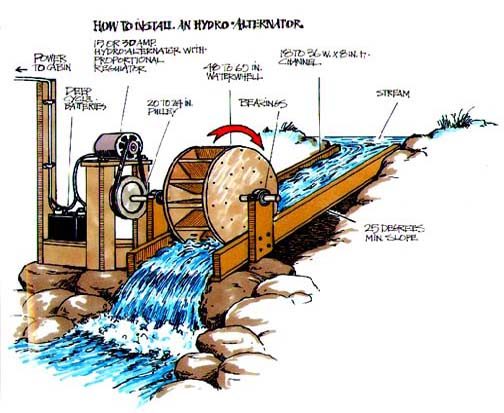
MicroHydro Generator
If your homestead can take advantage of water sources to produce electricity, then you have come to the right place. Here are the ins and outs of water-powered electrical production, from the microhydro web site. The link at the end takes you to the site for more info.
Water poweris as old as civilization . If you live in an old mill or have an upland stream flowing through or close to your property, you probably have a site suitable to generate some or all your domestic power requirements. If there is insufficient power for your needs electrically,you might still be able to use water power to drive a water source heat pump.
The main power requirements are in the winter months, so there should be little or no conflict with other river demands. Adequate provisions may have to be made for migratory fish, and if construction is needed, take care not to dam up the area. Check land drainage upstream of your intake. Construct all schemes in an unobtrusive and environmentally sensitive manner, and where appropriate buy drawings of proven designs.
The power available from a stream is determined by the head and flow of water on the particular site. This power is harnessed by constructing a dam or diverting the flow in such a way that all the fall occurs in one place. Where it is not practical to construct a channel, the water may be piped and the head of water is exploited as a high velocity jet driving an Impulse Turbine. The power available is a function of the fall (head) and flow so building a large waterwheel on a low fall will only increase the cost and reduce the shaft speed but not increase the power.
Water wheels are limited to sites with a head of less than 10 meters. They are aesthetically pleasing and have good performance under low water conditions. Unfortunately, due to their size, they are both costly to build and install, largely because of the gearing required to increase the shaft speed, typically from 10 to 1500 rpm. The use of low speed generators does not help since it is the low speed end of the drive which is the expensive part.
Water turbines, on the other hand, are able to make use of a very wide range of head, from less than a meter to many hundreds of meters. To cover the full range of sites, it is necessary to make use of several different types of turbine. It is not that you cannot use one type of turbine for all sites but that each design has it economic and hydraulic area.

One Response
Dear Sir
I am trying to contact Nick Rosen – he sent an e_mail requesting info on off-grid applications of micro hydro power to be used for a documentary he is going to produce. I have been running a MHP project here in Indonesia for the past 15 years and we would have heaps of projects which could be a focus for such a documentary if he was interested. If so he should contact me directly vai e_mail.
Regards Mark Hayton